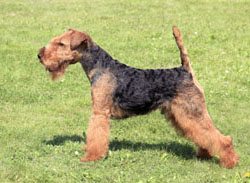Welsh Terriers are medium-sized dogs with black & reddish tan or grizzle coats. The coat is coarse, wiry, hard, and dense, and these dogs have a soft and short undercoat. The breed's small eyes are almond shaped and dark, and the ears are V-shaped and fold forward. Welsh Terriers measure 15 to 15.5 inches tall at the shoulder and weigh 20 to 22 pounds.
They appreciate daily walks on a leash, vigorous play sessions in the backyard, and a safe area to run, hunt, and explore in.
Spirited, friendly, and intelligent, the Welsh Terrier makes a great companion animal for families with children and other pets. These outgoing dogs have a strong desire to please, but they can be difficult to housetrain. They are patient with young children, can handle rough play, and love to run and play outdoors.
A Welsh Terrier named Charlie once lived in the White House during the administration of John F. Kennedy. This little dog belonged to Caroline Kennedy.
Independent, cocky, and highly intelligent, the Welsh Terrier makes a great house pet for active families. These energetic and inquisitive dogs tend to find trouble everywhere they go; it's a good idea to keep them busy in order to channel their excess energy into productive areas. They are calmer than most other terrier breeds and get along very well with children, but they may be too rambunctious and impatient around younger kids.
These dogs love nothing more than to dig, swim, run, fetch, and play outdoors. They appreciate daily walks on a leash, vigorous play sessions in the backyard, and a safe area to run, hunt, and explore in. Welsh Terriers like to chase small animals, including cats, squirrels, and rabbits, and they have a habit of walking up to strange dogs. For these reasons, the breed must be kept on a leash or inside a securely fenced yard at all times when outdoors.
Although active and mischievous, the Welsh Terrier has a strong desire to please and a steady personality. The breed is usually well behaved, mild-mannered, and calm when indoors. They do have a protective side, though, and they make good watchdogs. Welsh Terriers are not naturally aggressive, shy, or nervous.
Welsh Terriers are generally healthy, but they are known to suffer from some health problems that negatively affect length or quality of life. Acquiring a Welsh Terrier puppy from a reputable source who keeps detailed medical and family histories is a good first step in ensuring a healthy adult dog.
Some Welsh Terriers may develop patellar luxation, hypothyroidism, and allergies. Eye conditions are also common in the breed and may include cataracts, lens luxation, distichiasis, dry eye, and glaucoma. Additionally, Welsh Terriers can experience reduced mobility and health if allowed to become overweight or obese. Attention to portion sizes and other weight management techniques are an important part of caring for these dogs.
With daily exercise, a healthy diet, routine veterinary checkups, and timely vaccinations, Welsh Terriers typically live a full life of 10 to 14 years.
Although they are stubborn and highly intelligent, Welsh Terriers take well to training, provided they start early. They are independent, but they are also eager to please. Positive reinforcement techniques, consistency, and lots of patience help ensure training sessions are successful. Short and fun sessions are more effective than lengthy or repetitive ones.
Welsh Terriers can be difficult to housebreak. Sticking to a consistent routine, providing plenty of opportunity to go outside, and rewarding successful attempts will all help. These dogs respond better to affection and kindness in training than to harsh criticism, which can cause the breed to become defensive and shut down.
Welsh Terriers tend to find their own fun when bored or lonely. This often means chasing small creatures, digging giant holes in the backyard, and barking at odd hours. Keeping these dogs busy with mental and physical tasks and daily exercise will go a long way toward preventing problem behaviors.
Welsh Terriers need regular grooming to maintain their characteristic look. Combing should be done every other day or so, and the breed needs clipping and stripping every two to three months. Inexperienced pet owners may want to hire a professional groomer, especially if the Welsh Terrier is to be shown.
Bathing these dogs is only necessary if the coat becomes very dirty or the Welsh Terrier rolls around in something stinky, sticky, or toxic. A pH-balanced canine shampoo will gently clean the coat without causing skin irritation. It's important to thoroughly rinse the coat after washing to remove all traces of soap residue.
The nails need trimming every few weeks and the teeth should be brushed daily with a vet-approved toothpaste and toothbrush designed for use on dogs. Weekly ears examinations should focus on checking for redness, odor, discharge, and other signs of ear infection. Dirt, debris, and excess ear wax can be safely removed from the ears with a cotton ball and otic cleanser.
Welsh Terriers originated in Wales hundreds of years ago. They were once known as Black-and-Tan Wire Haired Terriers and were primarily used to hunt badgers, foxes, and otters across both land and water. The breed probably descended from the Black and Tan Rough Terrier that was common in Britain during the 18th and 19th centuries.
The breed became well known when dog shows increased in popularity during the mid-1800s. By 1884, a class existed for "Welsh or Old English Wire Haired Black and Tan Terriers," a description that still applies to today's dogs. The breed could be shown under either name.
Welsh Terriers were first brought to the United States in 1888 by Prescott Lawrence, and the Welsh Terrier Club of America was established in 1900. Today, these dogs are popular companion animals.
The American Kennel Club officially recognized the Welsh Terrier in 1888.

